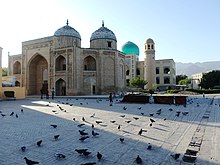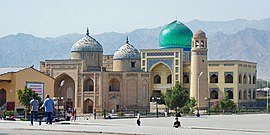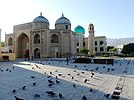Khujand
Khujand
Хуҷанд (Tajik) | |
|---|---|
| Website | www |
Khujand (
Khujand is one of the oldest cities in
History


Antiquity
Khujand may have been the site of
The Sheik Muslihiddin Mausoleum and Jami Masjidi Yami mosque, together with the fortress of Khujand, which was built over 2,500 years ago together and underwent several stages of complete destruction and renovation, were preserved by Khujand, as were some monuments from the 16th-17th century.[6]
Post-classical
In the early eighth century AD, Khujand was captured by the forces of the
Russian Empire
In 1866, as most of Central Asia was occupied by
Soviet Union
During the initial period of Soviet power in Central Asia, Khujand was part of the Turkestan ASSR that was created in 1918. When the latter was dismantled in 1924 on the principle of national delimitation, the city became a part of the Uzbek Soviet Socialist Republic. In 1929, the previously created Tajik Autonomous Soviet Socialist Republic (contained within the Uzbek SSR) was upgraded to union-level republic as the Tajik Soviet Socialist Republic, and in order to gain a sufficient number of inhabitants (preferably from the titular ethnic group) the city of Khujand and the surrounding area, inhabited mainly by ethnic Tajiks, was transferred by Soviets from the Uzbek SSR to the Tajik SSR.
The city was renamed Leninobad on 10 January 1936[8] and it remained part of the Soviet Union until 1991.

Now a part of the Tajik SSR, Leninobad became the second-largest city in the republic, though the city's location within the historically more urban, prosperous, and commercially central Fergana Valley and a long history of being a densely populated urban centre meant that Khujand and its region were sometimes viewed as more developed and cosmopolitan than the newly designated capital and boom-town of Dushanbe/Stalinabad (the latter was a small town of 6,000 when the Tajik SSR was created in 1926 and had reached over 200,000 inhabitants ten years later).[9]
Post-Soviet period and independence
It reverted to its original name in 1992 after the breakup of the Soviet Union and the independence of Tajikistan, and the city continued to be the second-largest city in the nation.
In 1996 the city experienced the
In the early 2000s many residents of Khujand had little to no access to water, and what water they did have was unsafe to drink and had to be boiled. In 2004, The Swiss State Secretariat for Economic Affairs and the
On 3 September 2010, a suicide attack was committed in the city by the al-Qaeda linked Jamaat Ansarullah militant group, resulting in the deaths of 4 people.[11][12]
In April 2017, Pastor Bakhrom Kholmatov was detained after a raid on Sunmin Sunbogym Protestant Church in Khujand. Kholmatov was accused of singing too loudly and "interfering with the comfort and rest" of people who lived nearby, and jailed for three years.
Transportation

The 5-km tunnel, located 80 km northwest of Dushanbe and built with assistance from Iran, is also a transit route between Dushanbe and the Uzbek capital of Tashkent. Previously, particularly during cold seasons, the lack of a direct link between northern and southern Tajikistan often led to disruptions of commercial activities in the region [16]
Education
The city is home to
Demographics
Khujand is mainly inhabited by ethnic Tajiks. Results of population census carried out in 2010: Tajiks – 84%, Uzbeks – 14%, Russians – 0.4%, and others – 1.6%. Sunni Islam is a mainly practiced religion in the city.[8] The population of the city is 181,600 (Report of Statistical Agency 2019).[8] The population in Khujand agglomeration is 931,900 people (2019).
Cultural sites

The city is home to the Historical Museum of Sughd located within the Khujand Fortress and having around 1200 exhibitions with most being open to the public.[17] The Sheikh Muslihiddin mausoleum is located on the main square across the Panjshanbe Market (Бозори Панҷшанбе / Persian for "Thursday's Market"), one of the largest covered markets in Central Asia.[18]
Climate
Khujand experiences a temperate semi-arid climate (Köppen climate classification BSk) with cold, snowy winters and hot, dry summers. Precipitation is light, and it generally falls in winter and autumn.
| Climate data for Khujand (1991–2020, extremes 1936–present) | |||||||||||||
|---|---|---|---|---|---|---|---|---|---|---|---|---|---|
| Month | Jan | Feb | Mar | Apr | May | Jun | Jul | Aug | Sep | Oct | Nov | Dec | Year |
| Record high °C (°F) | 16.6 (61.9) |
22.1 (71.8) |
28.8 (83.8) |
36.5 (97.7) |
39.9 (103.8) |
43.5 (110.3) |
45.9 (114.6) |
43.8 (110.8) |
39.8 (103.6) |
33.8 (92.8) |
25.0 (77.0) |
18.9 (66.0) |
45.9 (114.6) |
| Mean daily maximum °C (°F) | 4.2 (39.6) |
7.2 (45.0) |
14.9 (58.8) |
22.3 (72.1) |
28.6 (83.5) |
34.2 (93.6) |
35.7 (96.3) |
34.1 (93.4) |
28.8 (83.8) |
21.0 (69.8) |
12.3 (54.1) |
5.9 (42.6) |
20.8 (69.4) |
| Daily mean °C (°F) | 0.9 (33.6) |
3.3 (37.9) |
9.7 (49.5) |
16.1 (61.0) |
21.9 (71.4) |
26.9 (80.4) |
28.6 (83.5) |
26.8 (80.2) |
21.4 (70.5) |
14.4 (57.9) |
7.5 (45.5) |
2.5 (36.5) |
15.0 (59.0) |
| Mean daily minimum °C (°F) | −1.6 (29.1) |
−0.3 (31.5) |
5.5 (41.9) |
10.7 (51.3) |
16.2 (61.2) |
20.4 (68.7) |
21.9 (71.4) |
20.1 (68.2) |
14.9 (58.8) |
9.1 (48.4) |
3.8 (38.8) |
−0.1 (31.8) |
10.1 (50.1) |
| Record low °C (°F) | −22.8 (−9.0) |
−22.2 (−8.0) |
−13.6 (7.5) |
−3.9 (25.0) |
0.8 (33.4) |
8.7 (47.7) |
10.5 (50.9) |
7.0 (44.6) |
−1.1 (30.0) |
−6.8 (19.8) |
−18.8 (−1.8) |
−20.0 (−4.0) |
−22.8 (−9.0) |
| Average precipitation mm (inches) | 14 (0.6) |
20 (0.8) |
37 (1.5) |
42 (1.7) |
48 (1.9) |
10 (0.4) |
2 (0.1) |
2 (0.1) |
2 (0.1) |
15 (0.6) |
20 (0.8) |
16 (0.6) |
228 (9.2) |
| Average precipitation days | 11.4 | 11.0 | 12.7 | 12.6 | 12.0 | 6.3 | 4.1 | 2.6 | 3.2 | 6.8 | 7.4 | 10.4 | 100.5 |
| Average relative humidity (%)
|
77.8 | 75.4 | 64.0 | 56.3 | 48.7 | 34.8 | 33.8 | 38.4 | 43.3 | 55.4 | 75.2 | 76.4 | 56.6 |
| Mean monthly sunshine hours | 126 | 131 | 168 | 211 | 297 | 358 | 382 | 363 | 300 | 225 | 160 | 106 | 2,827 |
| Source 1: Pogoda.ru.net, NOAA (sun 1961–1990)[20]
| |||||||||||||
| Source 2: climatebase.ru (precipitation days, humidity),[21] | |||||||||||||
Sister cities
Notable residents
- Munzifa Gafarova (1924–2013), Tajikistani philosopher
- Ashura Nosirova (1924–2011), Tajikistani dancer
- Bakhtiyor Odinaev, Tajikistani stage manager, costume designer and artist
- Manzura Uldjabaeva (born 1952), Tajikistani artist
- Henri Weber (1944–2020), French politician
See also
- Hephthalites
- Khujand Airport
- Technological University of Tajikistan
- Khujand State University
- Historical Museum of Sughd
- Khujand prison riot
References
- ^ "Population size, Republic of Tajikistan on January 1, 2019" (PDF) (in Tajik). Tajikistan Statistics Agency. 2019. p. 17. Archived from the original (PDF) on 2 July 2015. Retrieved 28 March 2020.
- ^ "КОНСТИТУЦИЯ РЕСПУБЛИКИ ТАДЖИКИСТАН". prokuratura.tj. Parliament of Tajikistan. Retrieved 9 January 2020.
- ISBN 978-1-5381-0252-7.
- ISBN 0-306-81268-1.
- ^ "Khujand: a travel guide". Caravanistan. Retrieved 2019-12-08.
- ^ "Khujand". Retrieved March 24, 2021.
- ^ A Country Study: Tajikistan, Tajikistan under Russian Rule, Library of Congress Call Number DK851 .K34 1997
- ^ a b c About Khujand, http://fezsughd.tj/en/about_khujand/ Archived 2014-12-24 at the Wayback Machine
- OCLC 1013988565.)
{{cite book}}: CS1 maint: location missing publisher (link - ^ International Crisis Group. "Water Pressures in Central Asia", CrisisGroup.org. 11 September 2014. Retrieved 7 October 2014.
- ^ Pannier, Bruce (13 May 2022). "Northern Afghanistan and the New Threat to Central Asia". Foreign Policy Research Institute. Retrieved 2022-05-15.
Jamaat Ansarullah, for instance, is a terrorist group from Tajikistan that claimed responsibility for a suicide bomber attack in the northern Tajik city of Khujand in September 2010 that killed four people.[7] The Tajik government launched a crackdown on suspected Jamaat Ansarullah members and since then the group has been operating alongside the Taliban in northern Afghanistan.
- ^ Zenn, Jacob; Kuehnast, Kathleen (October 2014). "Preventing Violent Extremism in Kyrgyzstan" (PDF). United States Institute of Peace. Retrieved 15 May 2022.
Jamaat Ansarullah first carried out an attack in 2010, when it claimed responsibility for an al-Qaeda-trained member's suicide bombing at a police station in Khujand, a city in Tajikistan's northern province of Sughd in the Fergana Valley.
- ^ "Prisoner Alert - Bakhrom Kholmatov". www.prisoneralert.com.
- ^ http://www.caravanistan.com/wp-content/uploads/2012/02/central-asia-railroad-train-map-kazakhstan-uzbekistan-kyrgyzstan-tajikistan-turkmenistan-afghanistan.gif [bare URL image file]
- ^ "Train in Tajikistan". Caravanistan. 28 February 2023.
- ^ "Tajikistan to complete construction of major tunnel in 2015 | Shanghai Daily". archive.shine.cn. Archived from the original on 2021-03-05. Retrieved 2020-08-13.
- ^ "Khujand fortress". www.advantour.com.
- ^ "Azianatravel.com". www.azianatravel.com. Archived from the original on 2018-07-19. Retrieved 2014-06-04.
- ^ КЛИМАТ УЛАН-БАТОРА (in Russian). Pogoda.ru.net. Retrieved 4 January 2015.
- ^ "Leninbad (Khujand) Climate Normals 1961–1990". National Oceanic and Atmospheric Administration. Retrieved 18 December 2019.
- ^ "Leninabad, Tajikistan". Climatebase.ru. Retrieved 30 January 2013.
Sources
- Hill, John E. 2004. The Peoples of the West from the Weilue 魏略 by Yu Huan 魚豢: A Third Century Chinese Account Composed between 239 and 265. Draft annotated English translation. Weilue: The Peoples of the West (See under the heading for "Northern Wuyi").
External links
- Official website (in Russian)













